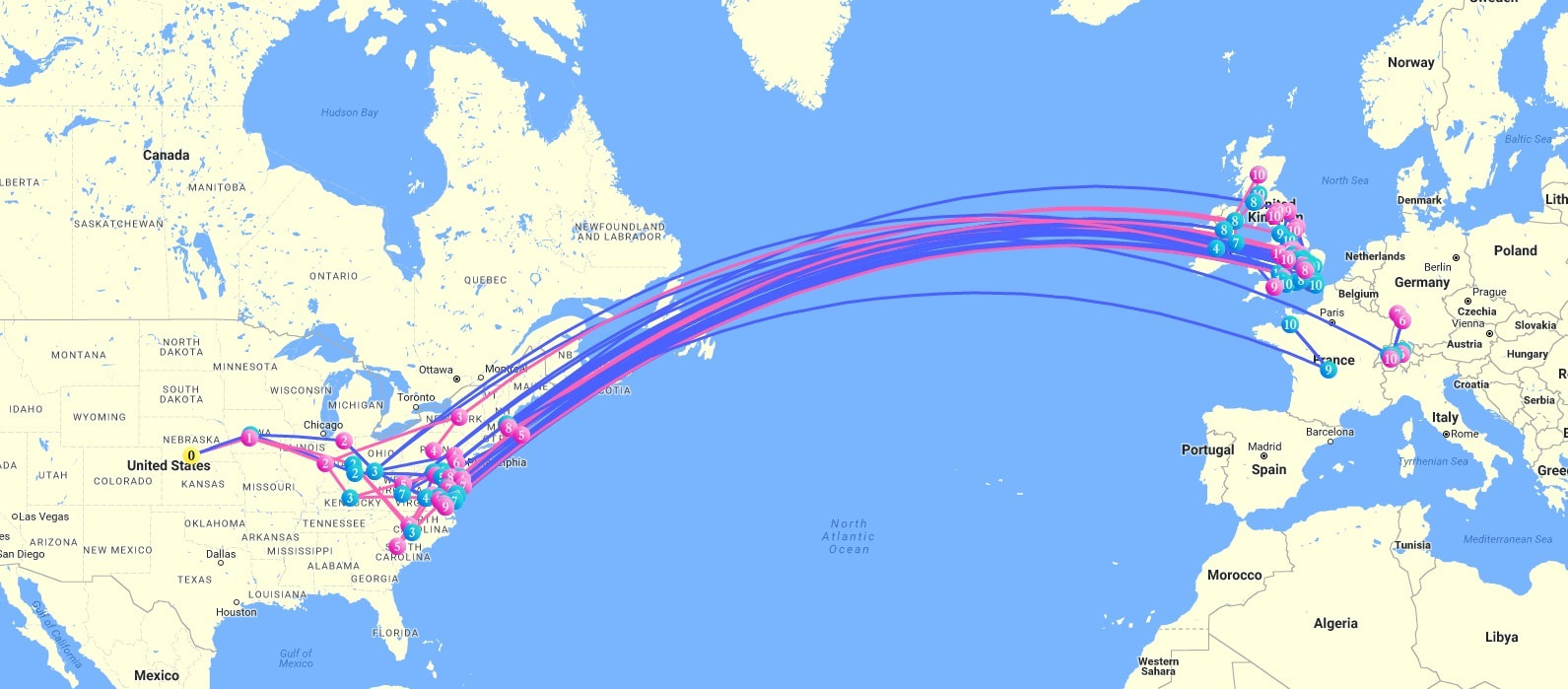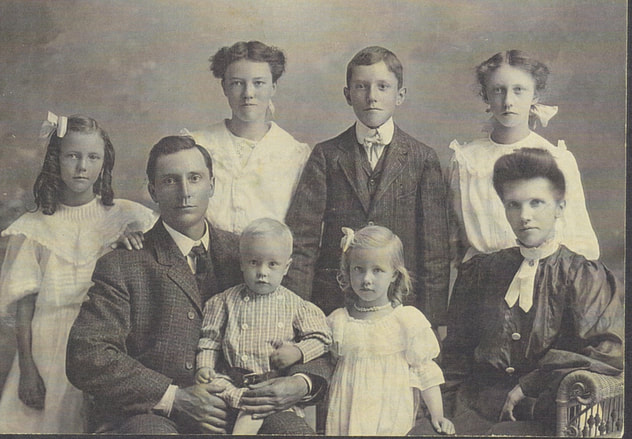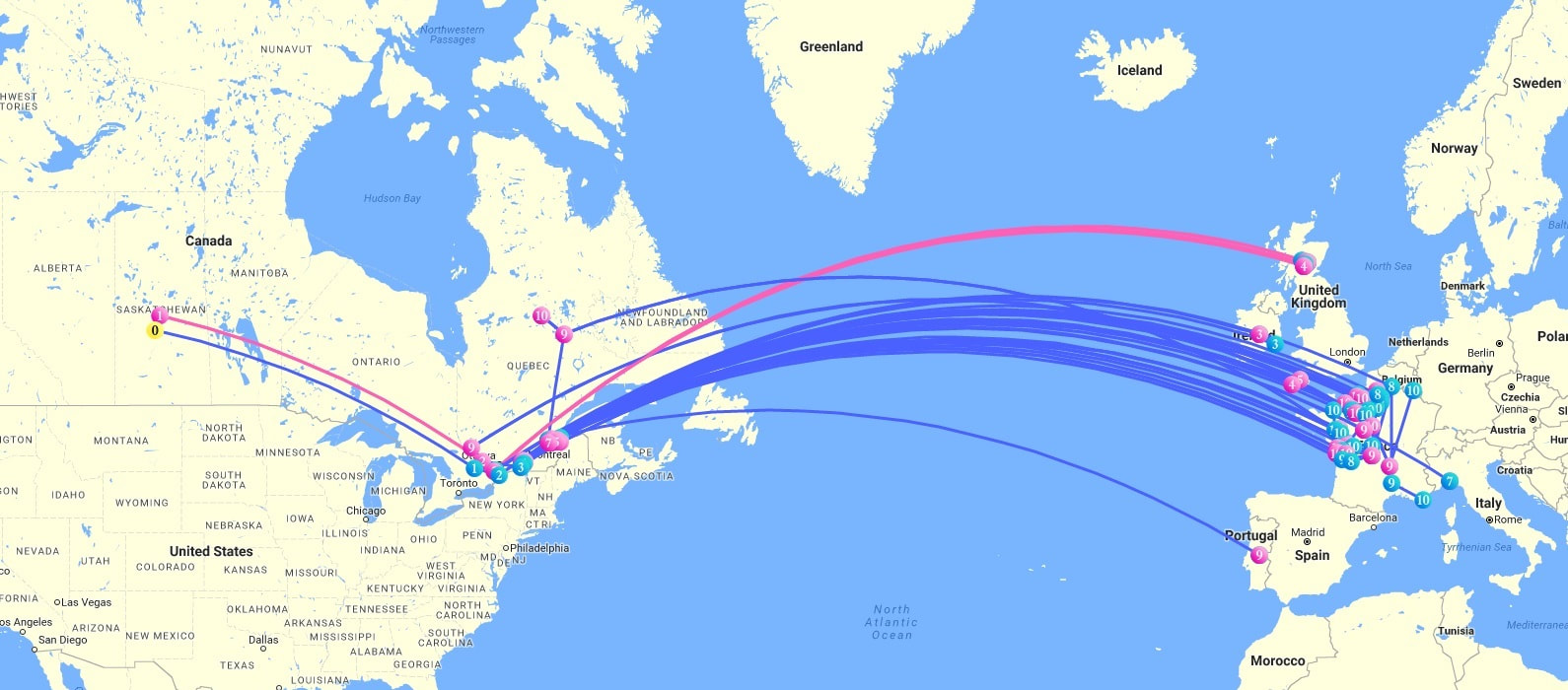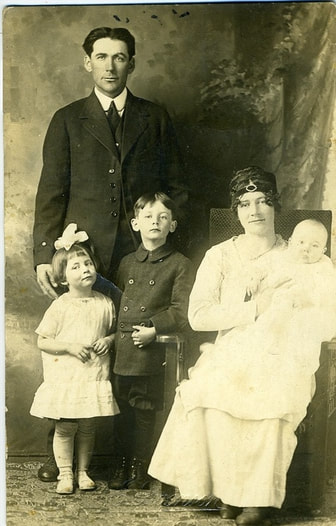The genetic code of my father exposed that he, like most North Americans, is a mixed breed. He is Scottish, Irish, Cornish, English, and German with even traces of African, and Native American. My father and his two brothers are the children of Lowell Leon Simpson and Grace Merle Lorraine Davis. The Simpson roots stretch back to the colonial days of the United States while the Davis side of the family immigrated to Canada from Ireland, Scotland, and Cornwall in the mid-19th century and from France in the 17th and 18th centuries.
Simpson
It appears that our Simpson family has its roots in the mid-17th century, particularly in or around Berwickshire, a historic county in the southern part of Scotland. Our Simpson ancestors were primarily from this region, living through tough times on the barren hillsides of lowland Scotland. They dealt with threats from both Highland and English invaders, endured hardships such as the plague and malaria, quarreled over coveted lands with their neighbors, and found solace in their strong adherence to Presbyterianism.
During the 19th century, the Simpsons were categorized as Scots-Irish. This label was used extensively for those of Scottish or northern English ancestry who migrated to America amidst a wave of 18th-century Ulster-Scots immigrants. If the Simpsons were Scots-Irish, it is possible that they left the harsh life in Berwickshire, attracted by the promise of a better future in Ireland. Here, English rulers were trying to quell the continually defiant Irish by introducing English and Scottish settlers. However, the local Irish population resisted these newcomers, leading to a decade of violent conflict that persuaded the Simpsons to continue their journey.
The Simpsons, regardless of whether they were of Scottish or Scots-Irish lineage, were part of the thousands who endured the dark, damp, disease-ridden holds of ships to cross the Atlantic, a voyage lasting weeks or even months, to reach the New World. Their first port of call may have been Virginia, but they would have quickly realized that the best lands were already under the possession of wealthy planters. However, they found unclaimed land in the Pennsylvania colony, which at that time incorporated the territories of Delaware, offering them an opportunity to establish a new life.
During the 19th century, the Simpsons were categorized as Scots-Irish. This label was used extensively for those of Scottish or northern English ancestry who migrated to America amidst a wave of 18th-century Ulster-Scots immigrants. If the Simpsons were Scots-Irish, it is possible that they left the harsh life in Berwickshire, attracted by the promise of a better future in Ireland. Here, English rulers were trying to quell the continually defiant Irish by introducing English and Scottish settlers. However, the local Irish population resisted these newcomers, leading to a decade of violent conflict that persuaded the Simpsons to continue their journey.
The Simpsons, regardless of whether they were of Scottish or Scots-Irish lineage, were part of the thousands who endured the dark, damp, disease-ridden holds of ships to cross the Atlantic, a voyage lasting weeks or even months, to reach the New World. Their first port of call may have been Virginia, but they would have quickly realized that the best lands were already under the possession of wealthy planters. However, they found unclaimed land in the Pennsylvania colony, which at that time incorporated the territories of Delaware, offering them an opportunity to establish a new life.
Our earliest known Simpson ancestor in America was William Simpson. On April 13, 1674, the Duke of York granted William Simpson a patent for a 400-acre parcel of land in what was then St. Jones County, Delaware. This region was later renamed Kent County in 1682 when control was passed to William Penn. This property, aptly named "Simpson's Choice," was located adjacent to the future village of Little Creek Landing, which would become a bustling center for the oyster industry. The following timeline provides a snapshot of the Simpsons' early history in Delaware:
The History of Delaware characterizes the Simpsons as "hardy, thrifty" individuals of Scotch-Irish descent who were early land grantees in the region. They were among the pioneers in Milford and have always been recognized as forward-thinking farmers, maintaining their lands in superior cultivation.
John Simpson Jr. married Mary Hilford, a descendant of English and Scottish immigrants, and the daughter of Mathew Hilford and Ann Maxwell. Their eldest son, Clement (1778-1838), married Comfort Dutton (1786-1813) in 1804. Comfort hailed from the English Dutton family, close associates of the Simpsons and potentially relatives through the Hilfords. The Duttons had migrated from England to Virginia in 1652, relocated to Maryland around 1700, and finally settled just north of Mispillion Hundred, in the Broadkill Hundred, around 1750.
After Comfort's untimely death sometime before 1812, Clement married Comfort's sister, Minty (1791-1844). They had two sons in 1814 and 1815, respectively. With a growing family and escalating land prices in Delaware, they were drawn to the promise of affordable land in the west. They sold their Delaware farm and relocated to Pickaway County, Ohio. There, they had four more children, the youngest of whom, Nelson, was born in 1826.
- 1674: The Duke of York awarded 400 acres of land, at the location of what is now Little Creek Landing, to our ancestor William Simpson.
- 1701-1711: Several land sales documents cited William Simpson as a neighboring landowner near Little Creek Landing.
- 1718: William Simpson leased an additional 200 acres in Kent County, agreeing to an annual rent of 16 shillings, 8 pence.
- 1732: William Simpson purchased a 120-acre plot north of Pemberton's Branch, in the vicinity of present-day Milton, Broadkiln Hundred.
- 1749: The third William Simpson gifted a 147-acre tract on the southern side of Mispillion Creek to his son, John.
- 1771: John Simpson divided two pieces of land, named Mount Pleasant and Simpson's Folly, totaling 67 acres, and bequeathed them to his sons, John Jr. and Robert.
- 1787: John Simpson Jr. bought a 43.5-acre plot for 30 pounds from his brother, Robert. The land was situated on the south side of Mispillion Creek, south of Beaver Dam Road, now part of South Milford.
- 1791: John Simpson Jr. sold a 112-acre parcel, incorporating parts of the Simpson's Crossroads and Mount Pleasant tracts, for 224 pounds.
The History of Delaware characterizes the Simpsons as "hardy, thrifty" individuals of Scotch-Irish descent who were early land grantees in the region. They were among the pioneers in Milford and have always been recognized as forward-thinking farmers, maintaining their lands in superior cultivation.
John Simpson Jr. married Mary Hilford, a descendant of English and Scottish immigrants, and the daughter of Mathew Hilford and Ann Maxwell. Their eldest son, Clement (1778-1838), married Comfort Dutton (1786-1813) in 1804. Comfort hailed from the English Dutton family, close associates of the Simpsons and potentially relatives through the Hilfords. The Duttons had migrated from England to Virginia in 1652, relocated to Maryland around 1700, and finally settled just north of Mispillion Hundred, in the Broadkill Hundred, around 1750.
After Comfort's untimely death sometime before 1812, Clement married Comfort's sister, Minty (1791-1844). They had two sons in 1814 and 1815, respectively. With a growing family and escalating land prices in Delaware, they were drawn to the promise of affordable land in the west. They sold their Delaware farm and relocated to Pickaway County, Ohio. There, they had four more children, the youngest of whom, Nelson, was born in 1826.
embeddable family tree updated live from WikiTree
Clement died in 1838, when Nelson was just 12 and his youngest sister only 7. Nelson's older brothers, Thomas and Emery, appeared to have stayed with the family, supporting their mother and younger siblings. The family then moved out to Indiana, where Comfort died in 1844. Nelson may have joined them for a time but ultimately continued further west to Iowa, where he met and married Rachel Woods in 1858.
The Woods family were Irish, first immigrating to Virginia and then moving west to Indiana, where James Woods married Aumain (Anna) Ritschhart, whose German-speaking father had immigrated from Switzerland. Nelson and Anna were prosperous farmers in Iowa, having several children and grandchildren. However, in a similar situation to his grandfather, he found Iowa becoming far too expensive for his sons to purchase land of their own. Around 1884, the entire Simpson clan picked up stakes and moved to Phelps County, Nebraska.
Named for his uncle, Nelson and Anna's youngest son, Thomas, was 18 when the family moved to the town of Holdrege. In 1890, he married Emma Hethcot. The Hethcots were originally Hathcocks from North Carolina, who had moved there from southwestern Viriginia, where they were a mix of Europeans, free Africans, and possibly Native Americans. When Mark Hathcock moved out to Indiana around 1800, he may have been up to 1/4 African but he was fair skinned enough to be counted as white on the census. In subsequent generations, the knowledge of their lineage was almost entirely forgotten.
Mark's grandson, Nathan Wilson Hethcot, moved from Indiana to Iowa in 1860 where he worked on the farm of James Harper and Alice Shillito. A year later, he wed their daughter, Mary Jane Harper, bought some land and began farming. Nathan was a skilled carpenter and bridge builder and sometimes traveled to neighboring states to offer his services. It was while building a bridge in Nebraska that something attracted him to the state because the next year Nathan moved his family to Red Willow County. His daughter, Emma, and Thomas had several children, including my grandfather, Lowell, in 1907.
Thomas and Emma moved with most of their children to Saskatchewan in 1915.
The Woods family were Irish, first immigrating to Virginia and then moving west to Indiana, where James Woods married Aumain (Anna) Ritschhart, whose German-speaking father had immigrated from Switzerland. Nelson and Anna were prosperous farmers in Iowa, having several children and grandchildren. However, in a similar situation to his grandfather, he found Iowa becoming far too expensive for his sons to purchase land of their own. Around 1884, the entire Simpson clan picked up stakes and moved to Phelps County, Nebraska.
Named for his uncle, Nelson and Anna's youngest son, Thomas, was 18 when the family moved to the town of Holdrege. In 1890, he married Emma Hethcot. The Hethcots were originally Hathcocks from North Carolina, who had moved there from southwestern Viriginia, where they were a mix of Europeans, free Africans, and possibly Native Americans. When Mark Hathcock moved out to Indiana around 1800, he may have been up to 1/4 African but he was fair skinned enough to be counted as white on the census. In subsequent generations, the knowledge of their lineage was almost entirely forgotten.
Mark's grandson, Nathan Wilson Hethcot, moved from Indiana to Iowa in 1860 where he worked on the farm of James Harper and Alice Shillito. A year later, he wed their daughter, Mary Jane Harper, bought some land and began farming. Nathan was a skilled carpenter and bridge builder and sometimes traveled to neighboring states to offer his services. It was while building a bridge in Nebraska that something attracted him to the state because the next year Nathan moved his family to Red Willow County. His daughter, Emma, and Thomas had several children, including my grandfather, Lowell, in 1907.
Thomas and Emma moved with most of their children to Saskatchewan in 1915.
Davis
The Davis name, meaning son of David, is the 6th most common name in North America. Of course, I'm not closely related to the vast majority of these Davis's, only a handful from Wexford, Ireland. Much of the story of the Davis family was collected over two decades ago by Garvin Boyle, Margaret Young, and Sadie Robinson, our distant cousins.
Our earliest known Davis ancestors lived in Wexford County, Ireland. However, while Davis is a not uncommon Irish name, it likely doesn't have deep Irish roots, possibly crossing St. George's Channel from Wales in the 17th century, when English rulers imported multitudes of Anglican and Presbyterian British peoples to supplant the Irish. The Davis name is of Norman origin, possibly appearing in Wales sometime after the invasion of 1066. However, the Normans were never large in numbers so while they had a powerful impact culturally, they were mostly absorbed by the native British population.
In 1824, 32 year old Joseph Davis entered into a lease for 104.5 acres in Garrynew with the rent of 119 pounds per year, under the condition that he plant 300 ash or fir trees within 3 years. The lease would would last for his life and the life of his 5 year old son, Joseph Henry Davis. Joseph Henry grew up during a relatively peaceful time in Irish history, the last rebellion defeated in 1798. This allowed him to not only help his father with the farm but also to grow up into a man of some learning.
However, when he was about 11 years old, in 1830, there was an angry, but relatively non-violent, uprising across Ireland, including Wexford, against the 10% tithe that farmers were forced to pay to the Anglican and Roman Catholic Churches. This "uprising" consisted of wide demonstrations, civil disobedience, and many angry fights and murders. Eventually, the British Crown withdrew the tithe in 1836. However, while the Davis family must have been grateful for the reduction in taxation, they would soon be confronted with the Great Irish Famine.
The famine was the result of a potato blight, which devastated the most plentiful crop in Ireland, a crop on which most subsistence farmers depended. The Davis family were not subsistence farmers, they would have been reasonably prosperous with 104 acres, but the blight would likely have affected them harshly as well. The crop loss in 1845 was between 1/3 and 1/2 of all cultivated acreage but in 1846, it was much worse, up to 3/4 of the crops failed. It was possibly about this time that Joseph Henry, his mother, and siblings decided to immigrate to Canada. Over a million Irish would also flee the island, mostly sailing for the United States. Of those who couldn't flee, over a million died of starvation.
Our earliest known Davis ancestors lived in Wexford County, Ireland. However, while Davis is a not uncommon Irish name, it likely doesn't have deep Irish roots, possibly crossing St. George's Channel from Wales in the 17th century, when English rulers imported multitudes of Anglican and Presbyterian British peoples to supplant the Irish. The Davis name is of Norman origin, possibly appearing in Wales sometime after the invasion of 1066. However, the Normans were never large in numbers so while they had a powerful impact culturally, they were mostly absorbed by the native British population.
In 1824, 32 year old Joseph Davis entered into a lease for 104.5 acres in Garrynew with the rent of 119 pounds per year, under the condition that he plant 300 ash or fir trees within 3 years. The lease would would last for his life and the life of his 5 year old son, Joseph Henry Davis. Joseph Henry grew up during a relatively peaceful time in Irish history, the last rebellion defeated in 1798. This allowed him to not only help his father with the farm but also to grow up into a man of some learning.
However, when he was about 11 years old, in 1830, there was an angry, but relatively non-violent, uprising across Ireland, including Wexford, against the 10% tithe that farmers were forced to pay to the Anglican and Roman Catholic Churches. This "uprising" consisted of wide demonstrations, civil disobedience, and many angry fights and murders. Eventually, the British Crown withdrew the tithe in 1836. However, while the Davis family must have been grateful for the reduction in taxation, they would soon be confronted with the Great Irish Famine.
The famine was the result of a potato blight, which devastated the most plentiful crop in Ireland, a crop on which most subsistence farmers depended. The Davis family were not subsistence farmers, they would have been reasonably prosperous with 104 acres, but the blight would likely have affected them harshly as well. The crop loss in 1845 was between 1/3 and 1/2 of all cultivated acreage but in 1846, it was much worse, up to 3/4 of the crops failed. It was possibly about this time that Joseph Henry, his mother, and siblings decided to immigrate to Canada. Over a million Irish would also flee the island, mostly sailing for the United States. Of those who couldn't flee, over a million died of starvation.
embeddable family tree updated live from WikiTree
Sometime previous to 1848, Joseph Henry crossed the Atlantic in a sailing ship, a journey requiring several weeks of hardship, locked in an swaying, suffocating, overcrowded hold for most of the day, the air thick with the odor of human waste and vomit, only allowed on deck for short periods, eating weevily bread, and subject to a wide range of debilitating diseases. After arriving in Halifax, he traveled east by ship to Montreal, and then further east by train to Elizabeth Town, Leeds County in Upper Canada, which today is known as Ontario.
Joseph Henry put his learning to use by working as a school teacher. He would need the income because not only was he supporting himself but his wife, Sarah Bolton, and their growing family. Sarah was also Irish, although we do not know if she journeyed to Canada with Joseph or if they met in Canada. After a few years in Leeds County, they purchased a farm near Wicklow in Lanark County, where they had several more children, including Joseph Henry Davis Jr.
Delilah Grace Burlinguet, who went by the name Grace, was the daughter of Charles Berlinguet and Mary Coumbs. Born in Quebec to a large Roman Catholic family, Charles went to live with his Protestant brother in Ontario while Mary was the daughter of Sampson Coumbs and Grace Cole, who immigrated to Canada from Cornwall, England. Sampson and Grace operated a tavern, brewed their own beer, as well as farmed. Grace married Joseph Henry Jr. in 1880, purchased a farm near their families near Wicklow and had a large family of 10 children.
Their oldest son was Charles Elijah Davis, born in 1881. Charles farmed with his father before moving west to modern day Saskatchewan to make his fortune. He worked for the Prince Albert Lumber Company for several years before opening a livery stable in Prince Albert. Charlie married Emily Campbell in 1909, the daughter of Peter Campbell and Emma McGregor, who were had moved out to Saskatchewan around 1880. Peter and Emma were both the children of Scottish immigrants and devout Presbyterians. Their daughter was equally devout and a dedicated teetotaler. Once, when Peter came home drunk, Emma refused to let him in the house for 3 days, until he had sworn off drinking.
Charlie and Emma moved from Prince Albert to Shellbrook, where they operated another livery stable, and had my grandmother, Grace Merle Simpson in 1915.
Delilah Grace Burlinguet, who went by the name Grace, was the daughter of Charles Berlinguet and Mary Coumbs. Born in Quebec to a large Roman Catholic family, Charles went to live with his Protestant brother in Ontario while Mary was the daughter of Sampson Coumbs and Grace Cole, who immigrated to Canada from Cornwall, England. Sampson and Grace operated a tavern, brewed their own beer, as well as farmed. Grace married Joseph Henry Jr. in 1880, purchased a farm near their families near Wicklow and had a large family of 10 children.
Their oldest son was Charles Elijah Davis, born in 1881. Charles farmed with his father before moving west to modern day Saskatchewan to make his fortune. He worked for the Prince Albert Lumber Company for several years before opening a livery stable in Prince Albert. Charlie married Emily Campbell in 1909, the daughter of Peter Campbell and Emma McGregor, who were had moved out to Saskatchewan around 1880. Peter and Emma were both the children of Scottish immigrants and devout Presbyterians. Their daughter was equally devout and a dedicated teetotaler. Once, when Peter came home drunk, Emma refused to let him in the house for 3 days, until he had sworn off drinking.
Charlie and Emma moved from Prince Albert to Shellbrook, where they operated another livery stable, and had my grandmother, Grace Merle Simpson in 1915.



